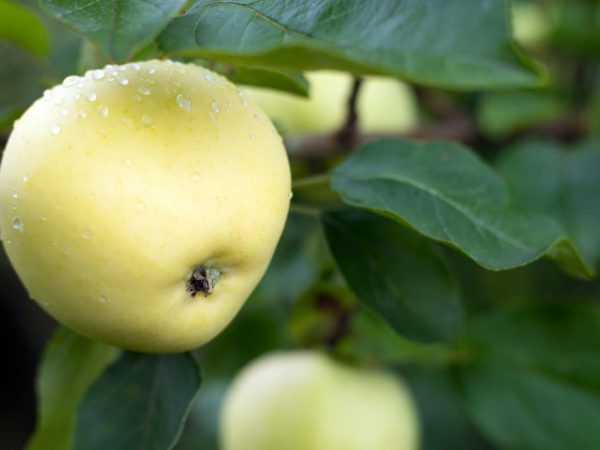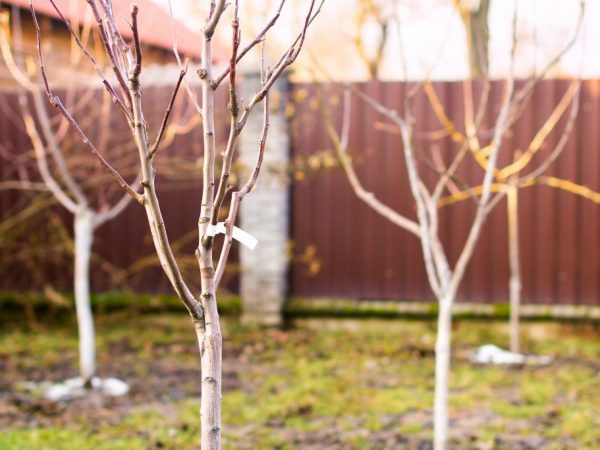Varietal characteristics of the Honey Crisp apple tree
Apple tree Honey Crisp (Honey Crisp) was bred in 1974: the hybrid received the best breeding qualities of popular old species. The variety has delicious crunchy fruits with juicy pulp. Beautiful apples are grown for sale or for long-term storage.

Varietal characteristics of the Honey Crisp apple tree
Characteristic
Winter culture bears fruit from the 4th year from the day of planting. A stable yield is established from the 9th year. The annual growth is constant: first, the tree grows upward, and only from 3-4 years old the side branches begin to lengthen, so the yield also grows.
The culture has the following characteristics:
- late ripening;
- high-yielding;
- resistant to diseases and pests, but only if properly cared for;
- average winter hardiness;
- yields will decrease if the apple tree is planted in the wrong soil.
Early maturity is the main advantage of the hybrid. Beautiful apples are grown for sale. They are stored for a long time - for this variety is appreciated by gardeners. The hybrid has few drawbacks. Subcutaneous spotting appears during storage. Fruits can peel off, which is a significant disadvantage of the variety.
Honey Crisp is not pollinated in complete isolation. Only under conditions of cross-pollination does it give a stable yield. To do this, choose varieties with characteristics similar to the species. The best options are Everest and Golden Delicious.
Description of fruits
The variety has one-dimensional and large fruits. The weight of one fruit is up to 250 g. The shape is round, slightly elongated. Asymmetry appears only on fruits that grow in low light conditions. The color is yellow-green. If there is a blush, then it is barely noticeable, blurred.
Honey Crisp apples have small subcutaneous spots.
The pulp is juicy and soft. There is a lot of juice in it, but the taste of the fruit is pleasant and non-watery. The tasting score is high - up to 5 points. The rind is thin and smooth. She shines weakly. The technical ripeness of the fruit is not reached until mid-September.
Description of the tree
The apple tree has medium vigor. The height of an adult tree is 3-4 m - it depends on the selected rootstock. Dwarf crops do not grow higher than 2 m, but they give a stable yield.
Description of the tree:
- in the early years, the crown is round, and the growth of the shoots is uniform;
- the older the culture, the more elongated its crown;
- after 5 years, the growth rate of branches decreases.
Honey Crisp has elongated dark green foliage. The branches are located at an acute angle to the main trunk. The thickness of the shoots is average. Rounded lentils.
Sapling selection
Honey Crisp seedlings have a good adaptation. Choose biennial trees that are already grafted. If you plant annual material, the apple tree will have a weak root system. This will reduce the number of ripe fruits on the branches. The grafted seedling has a strong root system and flexible roots.

A grafted seedling is chosen for planting.
There are shoots on material suitable for planting, but there are still no green leaves. Before placing the seedling in the ground, it is better to soak it in the "Fitosporin" solution to enhance the immunity of the planting material.
Landing
The hybrid is unpretentious to plant at any time of the year. The timing directly depends on the region in which such work is carried out. Apple tree Honey Crisp needs a spacious plot of land with good lighting. You can not choose lowlands where stagnant liquid constantly collects.
The preparation of the selected land plot is as follows:
- preparing a landing pit;
- dug up the territory adjacent to it;
- remove weeds;
- enrich the soil.
There is no need to add additional liquid. Planting includes watering, but only after the main work. So that the quality of the apples does not deteriorate, the grower immediately installs drainage. The optimum height of groundwater, which affects the availability of drainage, is 2.5 m.
If the water source is higher, the root system can be damaged. Additionally, a stake is installed, which will serve as a reliable support for the seedling.
Timing
Apple trees are planted twice a year - this is a standard condition for any fruit tree. The varieties Gold, Hani and other similar species are best planted in the spring. The right time is May. At this point, the soil layer is warming up. You need to be in time before the flowering of neighboring crops, then the seedling will quickly take root.
Planting in autumn is carried out after harvest. By this time, the land is cleared of weeds, debris, old plants. The events differ in the timing of the preparation of the planting pit - until May, the hole is fertilized in the fall, and by September in 2 weeks. The planting schemes and the survival rate of the apple tree are the same.
Landing technology
Landing takes place according to the standard scheme:
- the dimensions of the pit are chosen for the size of the rhizome. The minimum depth is 50 cm, and the diameter is not less than a meter;
- A planting pit is a hole in which fertilizer is placed. In order for nutrients to penetrate into the upper layers of the soil faster, they must be left for at least a week. You can cover the well with foil to protect it from moisture. A week later, a hole is dug up and left again for a week;
- organics are used for feeding. This is humus or compost diluted with water;
- the seedling is placed in a pit. The site of grafting serves as a guide - it must remain above the soil layer;
- neatly level the roots. A layer of fresh soil is poured on top;
- the seedling is abundantly watered with 5-6 buckets of water;
- planting material is tied to a support.
To provide additional protection, a soil roller is formed around the trunk. It will keep excess moisture in the root system.
Care

The apple tree needs regular watering
The first year the seedling feeds from the planting pit. For this reason, it is so important to bring in a large amount of humus. The Honey Crisp hybrid is unpretentious, but without proper watering, it grows slowly. 3-4 irrigations are carried out per season. For this, rain or industrial water is used.
Previously, the liquid is left in the container for the whole day in the sun, so that the water is heated to the desired temperature. Drip irrigation is preferred. Good results are obtained by the procedure of combined watering and feeding.
Top dressing
From the second year, constant care is established, which includes soil fertilization.
You can improve the quality of Honey Crisp apples with the help of top dressing as follows:
- while the tree is growing, nitrogen and potash fertilizers are applied;
- complex feeds are needed during the flowering period;
- by August, phosphorus fertilizing is carried out.
Mulching is carried out for the winter. They use hay, grass and peat. In the cold season, the tree does not require any feeding or soil moisture. When the snow falls, it is not removed - this is a natural defense for the culture.
Pruning branches
Pruning is a must for a tree with dense branches, like the Honey Crisp variety.
In the spring, until buds have formed, pruning is carried out with a pruner or other garden tool.You need to remove old branches or those shoots that grow crooked.
In the fall, the second type of pruning is carried out - it is called sanitary. After harvesting, old, diseased and damaged shoots are removed. They weigh down the tree and prevent it from growing. Autumn pruning is carried out before cooling. Complex measures will extend the life of the apple tree.
Prophylaxis
The immunity of the variety is good. If prophylaxis is carried out, the tree does not get sick with powdery mildew or scab. Fungicides are used as a universal remedy. Spraying is carried out twice a year - before flowering and after harvesting.
Ripening and fruiting
An early ripening culture bears fruit in the 4th year, if a suitable stock is chosen.
If the tree blooms too early, the inflorescences are removed - there is no need to rush to get the harvest. In such conditions, the culture will not have time to form. As a result, the yield will be low. The average lifespan of a tree is 20 years. Weak crops do not live more than 15 years.
The flowering period depends on the region. The culture blooms at an ambient temperature of at least 22 ° C. In regions with warm climates, this happens by mid-April. Flowering lasts up to 20 days.
Harvesting and storage
Harvest not earlier than the end of September. Apples can remain on the branches, but only until the first frost.
Harvest gradually. The edges of the branches are freed first, and then their middle. The fruits are placed in wooden boxes. Plain plain paper serves as a flooring.
Store fruits in a cool room with a minimum level of humidity. The average shelf life of fruits is 6 months. If the apples start to deteriorate, they are sorted out and put into new boxes.
Gardeners reviews
Reviews of the apple variety Honey Crisp are positive. Experienced gardeners note that the tree grows well in regions with a temperate warm climate.
The apple tree is light-loving, but unpretentious. If you establish regular maintenance, you will not have to fear for a stable harvest. The cultivar's good resistance is another advantage for which gardeners love it.

